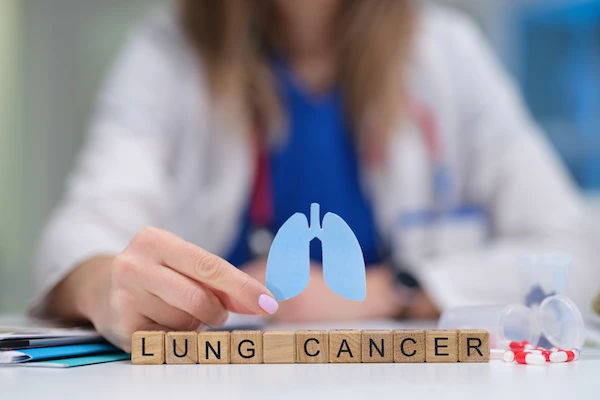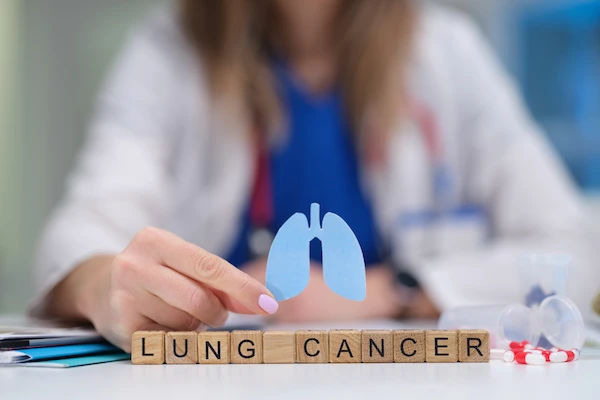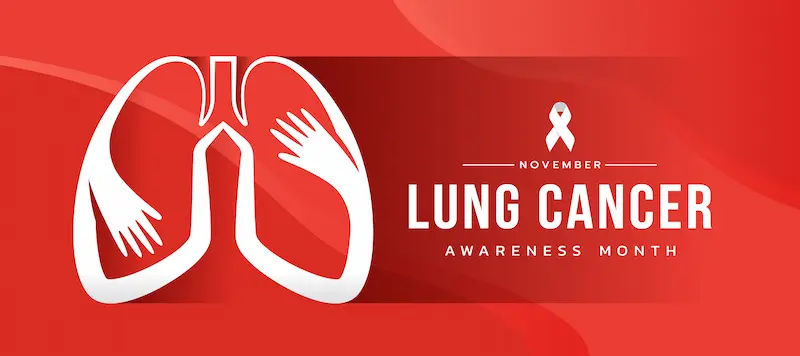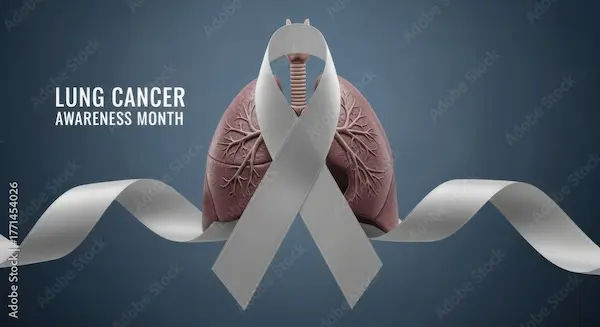What Leads To Signs Of Lung Cancer Risk Factors?
Learn about the leading risk factors and early warning signs of lung cancer. Understand what increases your risk and when to talk to your doctor.

Written by Dr. Md Yusuf Shareef
Reviewed by Dr. Shaik Abdul Kalam MD (Physician)
Last updated on 3rd Oct, 2025
.webp?tr=q-80,f-webp,w-350,dpr-2,c-at_max 700w)
Introduction
Lung cancer remains one of the most common and serious types of cancer worldwide. While a diagnosis can be frightening, understanding what contributes to its development is a powerful first step toward prevention and early detection. Many people associate lung cancer solely with smoking, but the reality is more complex. A combination of lifestyle choices, environmental exposures, and even genetic factors can influence your personal lung cancer risk. This article will demystify the leading risk factors, separating myth from fact. We'll explore everything from the well-known dangers of tobacco to the silent threat of radon gas in your home. By the end, you'll have a clear picture of what leads to signs of lung cancer risk factors and the actionable knowledge to protect your respiratory health.
The Uncontested Primary Cause: Tobacco Smoking
It’s no secret that smoking is the single biggest risk factor for lung cancer. According to the American Cancer Society, smoking is linked to about 80% to 90% of lung cancer deaths. The smoke from tobacco contains thousands of chemicals, at least 70 of which are known carcinogens—substances that can cause cancer by damaging the DNA in your lung cells.
Cigarette Smoking: Dose and Duration Matter
The risk isn't just about whether you smoke, but how much and for how long. This is often measured in "pack-years" (number of packs smoked per day multiplied by the number of years smoked). A person with a 30-pack-year history (e.g., 1 pack a day for 30 years or 2 packs a day for 15 years) has a significantly higher risk than someone with a 10-pack-year history. The good news? Quitting at any age can dramatically lower your lung cancer risk compared to continuing to smoke.
Beyond Cigarettes: Cigars, Pipes, and Low-Tar Options
Don't be fooled by alternatives. Cigar and pipe smoking also substantially increase the risk of lung cancer. Similarly, so-called "low-tar" or "light" cigarettes are not safer. Smokers often inhale more deeply or smoke more of these cigarettes to get the same nicotine hit, leading to similar levels of harmful exposure. Can vaping cause lung cancer? While e-cigarettes are generally believed to be less harmful than traditional cigarettes, they are not risk-free. Their long-term effects are still being studied, and they contain potentially harmful chemicals.Consult Top Specialists
Involuntary Risks: Secondhand Smoke and Environmental Exposure
You don't have to be a smoker to be affected by tobacco. Secondhand smoke—the combination of smoke from the burning end of a cigarette and the smoke breathed out by a smoker—is a proven cause of lung cancer in non-smokers. The CDC states that living with a smoker can increase a non-smoker's chance of developing lung cancer by 20-30%. This makes avoiding secondhand smoke a critical component of reducing your cancer risk.
The Invisible Threat in Your Home: Radon Gas Exposure
After smoking, radon gas is the second leading cause of lung cancer. Radon is a radioactive gas that occurs naturally from the breakdown of uranium in soil and rock. It is odorless, tasteless, and invisible. It can seep into homes and buildings through cracks in the foundation, becoming trapped indoors. When inhaled, radon particles can damage the lining of the lungs. The combination of radon exposure and smoking is particularly dangerous. The only way to know if your home has high radon levels is to test for radon gas. Affordable DIY test kits are available, or you can hire a professional.
Occupational Hazards: Workplace Carcinogens and Lung Health
Certain workplaces expose employees to carcinogens that can increase lung cancer risk, especially if exposure is over a long period and safety protocols are not followed.
Common High-Risk Occupations
Key substances include asbestos (historically used in insulation, fireproofing, and brakes), arsenic (in some pesticides and in electronics manufacturing), diesel exhaust, and some forms of silica and chromium. Workers in construction, shipbuilding, mining, and manufacturing may face these risks.
The Synergistic Danger of Smoking and Occupational Exposure
The risk multiplies for workers exposed to these substances who also smoke. For example, asbestos workers who smoke have a risk of lung cancer that is many times greater than the risks from either factor alone. This underscores the critical importance of both workplace safety measures and smoking cessation programs.
Family History and Genetic Predisposition
If you have a parent, sibling, or child who has had lung cancer, your own risk may be slightly higher. This could be due to shared environmental exposures (like secondhand smoke in the home) or inherited genetic mutations that make someone more susceptible to carcinogens. While not a major factor for most people, it's an important element of your overall health history to discuss with your doctor, especially if lung cancer appears in multiple close relatives at a young age.
Other Contributing Factors You Should Know
Air Pollution: The Urban Risk Factor
Long-term exposure to highly polluted air, particularly with fine particulate matter, can slightly increase the risk of lung cancer. This risk is much smaller than that from smoking but is a significant public health concern.
Previous Radiation Therapy to the Chest
Individuals who have undergone radiation therapy to the chest for other cancers (such as Hodgkin lymphoma or breast cancer) have a higher risk of developing lung cancer later in life, particularly if they are smokers.
The Role of Diet and Supplements
Some studies suggest that a diet rich in fruits and vegetables may offer a protective effect, while heavy alcohol consumption might increase risk. Surprisingly, some studies have found that beta-carotene supplements increase the risk of lung cancer in heavy smokers. It's always best to focus on a balanced diet to lower cancer risk rather than relying on supplements.
Lung Cancer in Never-Smokers: Understanding the Unique Risks
If lung cancer occurs in a non-smoker, it's often due to a combination of other factors discussed here: radon exposure, secondhand smoke, occupational hazards, air pollution, or genetic factors. Interestingly, lung cancer in never-smokers often has different genetic drivers (like EGFR mutations) than smoking-related cancers, which can open up specific, targeted treatment options.
Conclusion
Understanding the landscape of lung cancer risk factors empowers you to take proactive steps for your health. While some factors like genetics are beyond our control, many of the most significant risks—especially smoking, radon exposure, and secondhand smoke—are manageable. The first and most impactful action is to quit smoking or never start. Secondly, test your home for radon, a simple step that could save your life. Finally, if you have concerns based on your personal or family history, or if you experience persistent symptoms like a cough that won't go away, chest pain, or shortness of breath, it's crucial to seek professional medical advice. If symptoms persist beyond two weeks, consult a doctor online with Apollo24|7 for further evaluation. Early detection and intervention are key to successfully managing health outcomes. Your lungs are vital; taking steps to protect them is one of the most important investments you can make in your long-term well-being.
Consult Top Specialists
Consult Top Specialists

Dr. Hariprasath J
General Physician/ Internal Medicine Specialist
19 Years • MD (Gen Med), FCCP, Dip (Diabetology, UK)
Chennai
Apollo First Med Hospitals P H Road, Chennai
(200+ Patients)

Dr. Santanu Mandal
General Physician/ Internal Medicine Specialist
17 Years • MD (Physician), DNB (General Medicine)
Kolkata
MCR SUPER SPECIALITY POLY CLINIC & PATHOLOGY, Kolkata
(25+ Patients)

Dr. Abhishek Ranjan
General Practitioner
4 Years • MBBS
Kolkata
VDC Clinic, Kolkata
Dr. Sujay P R
General Physician/ Internal Medicine Specialist
3 Years • MBBS
Bengaluru
PRESTIGE SHANTHINIKETAN - SOCIETY CLINIC, Bengaluru

Dr. Vishal Kumar H
General Physician/ Internal Medicine Specialist
8 Years • MBBS, master class in critical care medicine, Advanced Post Graduate Diploma in Non Invasive Cardiology, certificate course in Cardiovascular Disease & Stroke, Certificate course in Common Mental Disorder
Bengaluru
Apollo Clinic, Basavanagudi, Bengaluru
Consult Top Specialists

Dr. Hariprasath J
General Physician/ Internal Medicine Specialist
19 Years • MD (Gen Med), FCCP, Dip (Diabetology, UK)
Chennai
Apollo First Med Hospitals P H Road, Chennai
(200+ Patients)

Dr. Santanu Mandal
General Physician/ Internal Medicine Specialist
17 Years • MD (Physician), DNB (General Medicine)
Kolkata
MCR SUPER SPECIALITY POLY CLINIC & PATHOLOGY, Kolkata
(25+ Patients)

Dr. Abhishek Ranjan
General Practitioner
4 Years • MBBS
Kolkata
VDC Clinic, Kolkata
Dr. Sujay P R
General Physician/ Internal Medicine Specialist
3 Years • MBBS
Bengaluru
PRESTIGE SHANTHINIKETAN - SOCIETY CLINIC, Bengaluru

Dr. Vishal Kumar H
General Physician/ Internal Medicine Specialist
8 Years • MBBS, master class in critical care medicine, Advanced Post Graduate Diploma in Non Invasive Cardiology, certificate course in Cardiovascular Disease & Stroke, Certificate course in Common Mental Disorder
Bengaluru
Apollo Clinic, Basavanagudi, Bengaluru
More articles from Lung Cancer
Frequently Asked Questions
1. What are the early signs of lung cancer in a non-smoker?
Early signs can be subtle and are similar to those in smokers: a persistent cough, shortness of breath, chest pain, hoarseness, or coughing up blood. Because lung cancer in non-smokers is often unexpected, these symptoms can be mistaken for other conditions, so it's important to get them checked out.
2. How can I test my home for radon gas?
You can purchase an affordable DIY radon test kit online or at most hardware stores. These kits are typically placed in the lowest lived-in level of your home for a specified period and then mailed to a lab for analysis. For more immediate results, you can hire a certified radon testing professional.
3. If I quit smoking 10 years ago, what is my lung cancer risk now?
Your risk drops significantly after quitting. After 10 years, your risk of dying from lung cancer is about half that of a person who is still smoking. However, your risk will never quite return to that of a never-smoker, which is why screening may still be recommended based on your age and smoking history.
4. Can air purifiers reduce lung cancer risk from air pollution?
HEPA air purifiers can reduce indoor levels of fine particulate matter, which is beneficial for overall lung health. However, they are just one part of a solution. The best approach is to reduce exposure to all major risk factors, not rely on a purifier alone.
5. Is there a genetic test for lung cancer risk?
While there are no routine genetic tests to assess general population risk, genetic testing is crucial for people already diagnosed with lung cancer. Testing the tumor tissue can identify specific mutations (like EGFR or ALK) that can guide targeted therapy, leading to more effective treatment.




